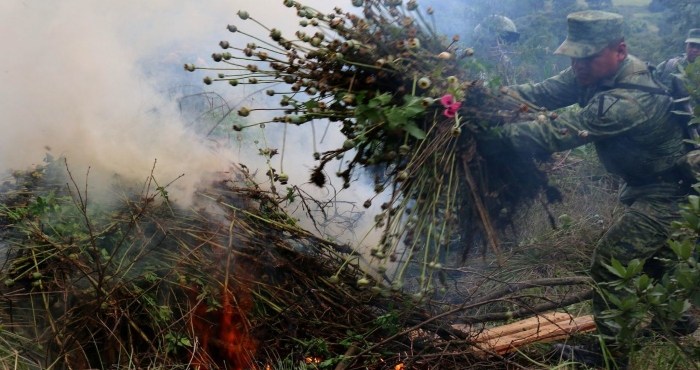
02/05/2021 (written by rramos) – A hostile encounter between opium poppy farmers and military personnel in the southern state of Guerrero illustrates the increasingly difficult plight of Mexico’s rural poppy growers, a situation that reflects broader shifts in the nature of drug production in the country.
Farmers Resist Eradicators to Defend Crops
The confrontation took place on the morning of January 24 in the town of San Miguel Totolapan, where a group of roughly 200 farmers gathered in an attempt to thwart a forced eradication operation being conducted by the Army. Equipped with clubs and sticks, the farmers tried to block the path of troops moving towards fields of opium poppy they had been cultivating. Shortly after the soldiers came upon the farmers’ blockade, a brawl involving pushing and shoving between the two groups ensued. In a phone interview with Sin Embargo, one of the farmers stated that some of the troops, estimated to number around 150, aimed their firearms at the growers, ultimately forcing them to desist and allow the soldiers to proceed toward the poppy fields. The farmer went on to claim that peasants in the area were motivated to challenge the troops because in the days preceding the January 24 encounter, the Army had destroyed 50 hectares of poppy plants that local residents had been cultivating across seven rural communities in the San Miguel Totolapan municipality.
Clashes between poppy growers and security forces looking to carry out crop eradication operations are not without precedent. Residents in poppy-producing areas, which are largely impoverished and marginalized, often feel compelled to defend poppy fields from destruction by authorities because these represent the only meaningful source of income for their families. However, disputes between poppy farmers and government forces appear to be occurring more regularly in Guerrero, which has long been an important hub of poppy cultivation in Mexico. Last year, farmers in the town of Heliodoro Castillo attacked Army helicopters with rocks and various types of projectiles in an attempt to ward off aerial fumigation of poppy fields in the area. In December 2020, poppy growers managed to drive away government eradicators following a tense standoff in San Miguel Totolapan, the same municipality in which the January 24 confrontation would take place only a month later.
Worsening Situation for Opium Poppy-Growing Communities
The growing number of incidents in which farmers have organized themselves to disrupt eradication efforts may be an indication of the increasing desperation felt by poppy-growing communities in the wake of deteriorating economic conditions. In particular, regions of Guerrero that have relied on poppy cultivation have been severely impacted by a dramatic collapse in the price of opium gum, which is extracted from poppy plants to be used in the production of heroin. Throughout the state, farmers have been forced to find other sources of income as earnings from growing poppy have dried up. According to the New York Times, the price of opium gum in Mexico has plunged rapidly, falling from a peak of up to $1,300 per kilo in 2017 to roughly $110 by mid-2019. This has set off a widespread exodus from rural towns and villages in Guerrero, with large numbers of farmers worried that the precipitous drop in the value of opium gum will push them further into poverty and leave them with no means to earn a sufficient living.
Criminal Focus Shifting in Favor of Synthetic Drugs
The significant decline in the price of opium gum has been attributed to drug trafficking organizations shifting their attention away from traditional, plant-based drugs like heroin, and toward synthetic drugs, such as fentanyl. Analysts have argued that this growing preference is due partly to the belief that synthetic drugs are considerably cheaper and less time-consuming to produce compared to plant-based drugs. In an interview with the San Diego Union-Tribune, Cecilia Farfán-Méndez, a researcher at the University of California, San Diego’s Center for U.S.-Mexican Studies, explains that the production of heroin depends on labor-intensive and expensive tasks that take place over prolonged periods of time, such as tending to large fields of poppy plants and processing opium gum. In contrast, synthetic drugs like fentanyl can be manufactured much more rapidly in clandestine labs because their production “doesn’t have to rely on acreage, farm laborers, pests, and weather,” all of which are critical factors in producing heroin. Along with reducing operational costs, a further advantage of fentanyl for drug trafficking organizations is its ability to generate larger profits, as the drug is significantly more potent than heroin, even in small quantities.
This new emphasis on synthetic drugs and decreased interest in heroin seem to be reflected not only in falling prices for opium gum, but also in remarkable fluctuations in the levels of poppy cultivation in Mexico. Data from the U.S. Office of National Drug Control Policy (ONDCP) showe that opium poppy cultivation in Mexico had skyrocketed from roughly 10,500 hectares (ha) to over 44,100 ha in the five-year period between 2012 and 2017. By 2018, however, poppy levels began to drop back down as fentanyl surged in popularity among drug traffickers and users, with the ONDCP estimating in July 2020 that poppy cultivation had fallen to 30,400 ha by 2019. If this downward trend continues, poppy farmers in Mexico may find themselves under greater financial strain, heightening the risk of more clashes with authorities over eradication as growers strive to preserve their dwindling source of livelihood.
Sources
“EU: la amapola y heroína de México, aún en niveles récord. ” Milenio. June 15, 2019.




